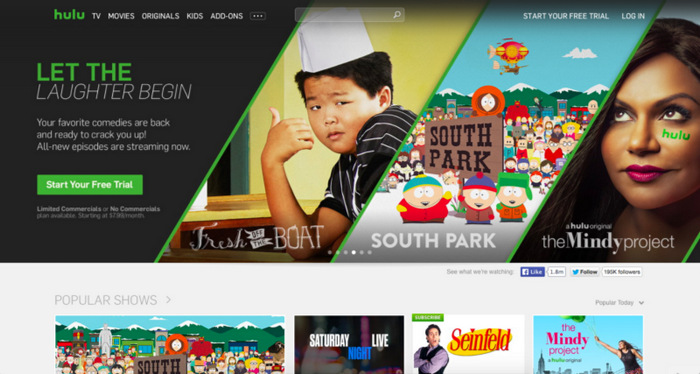SVOD Platforms- Past, Present, and Future.

Jim Packer (president of Worldwide TV and Digital Distribution at Lionsgate) and Mike Hopkins (CEO of Hulu) participated in a real gem of a talk during MIPCOM this year. The two professionals shared their insight on how SVOD (subscription video on demand) services are changing the television landscape. Their discussion revealed some interesting trends that also transition into and have an impact on the movies. The two are direct collaborators, as Lionsgate produces and distributes internationally Hulu original shows. This is not an exclusive collaboration, as Lionsgate also produces and distributes Orange is the New Black among others, for Netflix.
One of the biggest game-changers in the field of streaming platforms is the production of original content. Both Netflix and Hulu (as well as other competitors in the market) are investing in original content for their competitive advantage. Everybody is aiming to create brand-changing shows (like The Sopranos was for HBO). Audiences all around the world want and expect shows they can binge on and offering them that possibility has an impact on how these shows are produced and sold. While streaming has brought about this shift, the shows’ distribution can’t be limited to these platforms alone. As Packer argued, the key to success is being on every single platform- “you need to be wherever people might start the sampling”. He offered the example of the unexpected success of the DVD release of Orange is the New Black.
Why we found this interesting: In these conditions, the production of TV shows is likely to continue its way toward matching and surpassing the budgets of movie productions. With an average cost of 6 million $ per episode for shows such as Game of Thrones, TV shows already command mid-tier budgets that are now rarely available for cinema movies. Given the current popularity of TV series, it is a safer bet on the part of producers and one that they will likely continue to make.
When it comes to distributing television content, Lionsgate is at the forefront of change. According to Packer, their approach to the developments in the industry due to streaming platforms is to be flexible and open to change. They define this change particularly as challenging the traditional window strategy (a distribution term for a specific release period to a specific channel i.e. releasing to cinemas is a window while releasing to DVD is another)and adapting to each territory’s particularities. It’s proving to be a winning approach, as shown by their experience with releasing an entire Orange is the New Black season four weeks earlier than usual in China and allowing users to watch all episodes at once. This countered the effect of piracy and quadrupled the revenue.
We found this very interesting as it provides growing evidence that ease of access and convenience are great ways of staving off piracy and increasing revenue.
As for movies, international audiences are an important point of growth, but still a fairly new game for USA-based distributors. With the increased number of territories and because of the fact that the rights profile is different (shows have to be available virtually indefinitely), rights management for SVOD gets more complicated.
While Lionsgate is focused on exporting US shows internationally, Hulu, currently not planning to expand internationally, is looking to diversify the profile of their shows by adding international productions- both films and series. These programming decisions, Hopkins explained, are based on whether there are ex-pat populations in the US that can constitute a sizable viewership as well as on whether certain foreign shows or films can cross over into the general market. A case of the latter is Korean dramas whose viewership on Hulu goes beyond the Korean minority in the US.
We found this interesting because over time the focus on international markets will probably attract and involve more local talent. While the focus is now on creating shows that have the potential to be exported, it might be that soon SVOD platforms will venture into creating original content for each market.

According to Jim Packer, 5–7 years ago the strategy was to have as many advertising ‘fillers’ as possible (to take advantage of the high demand). Today the paradigm has shifted to an emphasis on high-quality content. While Hopkins admits that an ample offer lends itself to platforms such as Hulu (because it allows them to create a more personalized experience for the customers), when it comes to original shows the approach is also to focus more on quality rather than quantity. This concentrates and makes more aggressive the process of marketing the shows more. This focus on quality puts Lionsgate in a privileged position, where its track record attracts various players in the streaming market. Lionsgate does no output deals, which means they have to do individual approaches. While it might be more labor intensive, this strategy has 2 main advantages: it attracts better showrunners and better third-party partners. It seems rather evident that TV studios will be employing the blockbuster strategy going forward in the sense that they will gravitate toward the projects which have the best prospects of being fail-safe.
As viewers transition between different devices and are driven towards over-the-top services, there is also a lot of disruption in terms of advertising. Both Packer and Hopkins expressed their belief that advertising will continue to be part of the business model. Hulu has launched an ad-free plan which helps to attract some new users and to deter some of the existing ones to stay on the platform, but their most successful plan is still the one with limited ads. They have ensured they made that part of the experience by investing in programmatic advertising.
Lionsgate is still moving a lot of content into AVOD, because of their belief that the money will transition. The biggest change is in the metrics that they are using- focusing more on word of mouth, social media, etc, although they acknowledge the ratings are still a key metric, with ‘live +7” becoming more and more important. As viewers also tend to turn to a show several weeks/ months after release, metrics will change, but at this point “there is more written about stuff than it’s actually happening” said Jim Packer. While producers and distributors are keen on keeping advertisers on board, the effectiveness of advertising in its current form has been rightfully under scrutiny for a while. It will require some effort and openness to change on both sides to keep advertising as part of the business model.
One of these topics that have been written about a lot recently is how streaming impacts the bundle, particularly in the US, where the ‘big bundle’ (60- 80 $/ month) is common. Both Packer and Hopkins agree that in the future the bundle will continue to be the norm, with some “shaving” (downgrading to a slightly cheaper tear) and it will be compensated by the addition of SVOD services. The key to success is in these services being very targeted and branded and appropriately priced.
It might be the challenges to bundled TV experiences and advertising was understated in this discussion, as much of this came from the perspective of the domestic US market. Unlike Hulu, Netflix continues its expansion internationally, launching in Southern Europe later this month (October 2015), and reportedly planning to launch in South Korea as its next step in a bigger plan to penetrate the Asian markets. The response from these new customers, as well as from the TV carriers in these new territories has the potential to bring about a decisive paradigm shift.
If you would like to know more CONTACT US

